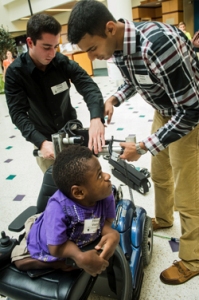Oct 5 2013
The last few weeks have been a whirlwind for three Rice University bioengineering students who have spent much of the past two years constructing a robotic arm for a patient at Shriners Hospital for Children in Houston.
 Rice students Matthew Nojoomi, left, and Nimish Mittal attach a robotic arm to Dee Faught's wheelchair during recent testing at Shriners Hospital for Children in Houston. (Photo by Jeff Fitlow)
Rice students Matthew Nojoomi, left, and Nimish Mittal attach a robotic arm to Dee Faught's wheelchair during recent testing at Shriners Hospital for Children in Houston. (Photo by Jeff Fitlow)
Matthew Nojoomi, Sergio Gonzalez and Nimish Mittal have been interviewed by Good Morning America, presented their project at a national conference and gathered more than 530,000 views on YouTube for a Rice-produced video that showed the R-ARM in operation.
The arm built for Dee Faught, who lives with osteogenesis imperfecta, also known as brittle bone disease, gets closer to completion every day. A second round of tests took place at Shriners Sept. 30, and the students are tweaking the device for permanent use by the Friendswood high schooler.
Though they admit to frequent checks on the YouTube views, the three juniors have tried not to let the attention distract them from their primary mission — helping the 17-year-old Faught gain a measure of freedom he’s never experienced.
The device made possible by support from Rice’s George R. Brown School of Engineering and the staff at Shriners was built at Rice’s Oshman Engineering Design Kitchen. The battery-powered arm attaches securely to Faught’s motorized wheelchair and moves up, down and out, while the chair itself allows him to move the arm from side to side.
The device gives Faught an extra 4½ feet of reach. “We designed it so he can go all the way down to the ground and all the way up to the highest shelf on his cabinet,” Nojoomi said.
Rice engineering team delivers robotic arm to Houston area teenager
The team built a two-stage controller for Faught. Because the youngster is a videogame fan, they modified a familiar Playstation controller as a primary controller for the arm. Gonzalez programmed the heart of the system, an Arduino microcontroller, with C++, and the entire team added safety switches that stop the arm from traveling too far in any direction.
“We have padding on the arm and interference detection that stops it if he touches it on the side, because he kind of leans toward one side,” Nojoomi said. “It has controller monitoring, so if the controller is disconnected, it shuts off. And there’s an emergency off switch.”
“All the joints are limit-controlled so he can’t overrotate the arm in any direction, to make sure there’s no excessive wear and tear,” Mittal said.
The flat grippers are capable of lifting items up to three pounds with 220 ounce inchesof force from each of two servomotors. “Obviously, there are other factors that come into how much he can pick up,” Nojoomi said, noting the 195 foot pounds (a measure of torque) for the base and 160 foot pounds for the arm. The students set the base to rotate at 20 degrees per second and the elbow at 25 degrees per second.
They also added a foot-activated switch to release the grip. “We wanted Dee to be able to catch things with both hands that are too heavy for him to catch with one,” Nojoomi said. And the arm is deliberately set to the side of the chair so Faught cannot accidentally drop an item on himself.
With Faught’s help as a beta tester, the Rice students hope to build more affordable robotic arms and may continue their work after graduation. “If Dee likes it and it works well for him, we want to get it out to as many people as we can,” Mittal said.